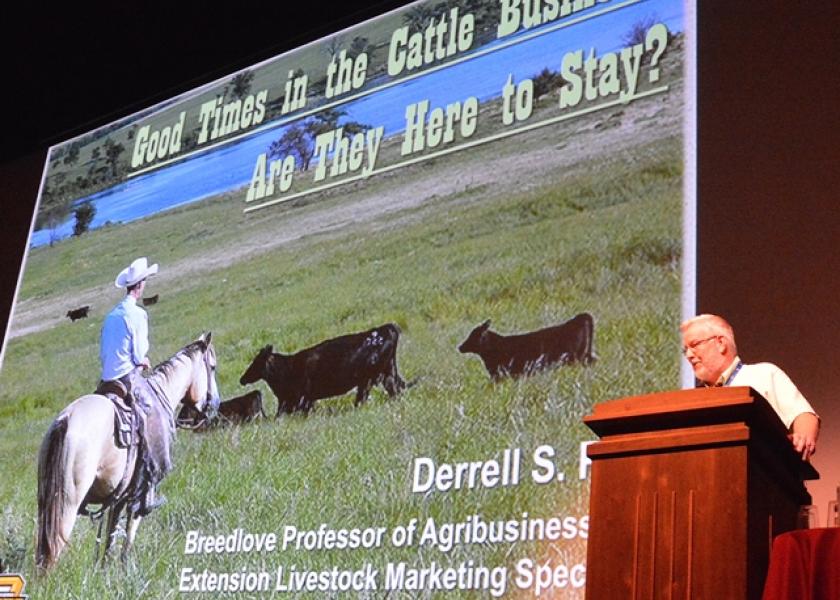‘Exciting Times’ in the Cattle Business Moving Forward

Texas A&M Beef Cattle Short Course features cattle market outlook and trends.
By: Blair Fannin, Texas A&M AgriLife Extension
As temperatures in College Station reached 100 degrees during for the opening general session of the 61st Texas A&M Beef Cattle Short Course, it could also accurately describe a red-hot cattle market the past two years.
“These are exciting times indeed, but are they here to stay?” said Jason Cleere, conference coordinator and Texas A&M AgriLife Extension beef cattle specialist, addressing one of the highest-attended short course events ever.
More than 1,680 beef cattle producers gathered at Texas A&M to hear the latest about the cattle market and future trends.
“I think there is a lot to look forward to down the road,” Cleere told attendees.
Dr. Derrell Peel, Oklahoma State University livestock marketing economist, said the cattle market may have topped earlier this year, but don’t expect a downward spiral in prices anytime soon. However, Peel said to “prepare for lower prices” according to decades of past charts and data.
“It’s been fun on the way up; it’s been easy to make money on the way up,” Peel said. “There still will be some good times ahead, but you’re going to have to manage costs in relation to the market. It all goes back to cost management. Now is a good time to invest some of those good returns you’ve had to help manage costs over the next few years. That might be investing in (replacement) females or brush control. I’m still optimistic. The best cure for high prices is high prices.”
According to the latest U.S. Drought Monitor, Peel said, drought conditions have improved dramatically and beef producers “have been able to switch from defense to offense” in building back herds.
“We are on the way back to seeing expansion,” Peel said.
U.S. cattle inventory was up 2.5 percent as of July 1, according to the U.S. Department of Agriculture-National Agricultural Statistics Service. Beef cow numbers totaled 30.5 million July 1 as compared to 29.7 million in 2014.
Other indicators include a 6.9 percent decline in cattle slaughter so far for 2015 as well as an 11.5 percent decline in heifer slaughter.
“That’s pretty strong evidence we are expanding,” Peel said.
Dr. Rick Machen, AgriLife Extension livestock specialist, Uvalde, discussed emerging issues in the beef industry. He said the recent ban lifted on imports from Argentina and Brazil will weigh on U.S.-produced grass-fed and organic beef markets.
“It’s quite likely some of these imports could compete one-on-one with some of the products you produce here,” Machen said. He advised those who produce grass-fed and organic beef in Texas and abroad to manage costs and keep a watchful on the issue as it could affect business.
When it comes to food and beef, Millennials, those born in the 1980s or 1990s, they want to know who raised it, how it was treated, where it came from, whether it contains genetically modified organisms, the environmental impact and whether it is sustainable.
“They want somebody that is tied to agriculture, somebody they can trust to answer their questions,” Machen said. “There is nobody better to tell our story than us.”
Machen encouraged beef producers to tell their story about stewardship and stockmanship and “tell it as often as you can.”
“Tell your grandkids to invite their friends to come out the ranch and tell your story. How we help the Millennials, the kids they are raising, is going to have a profound influence on who is inheriting the ranch on down the line.”
Other general session speakers included Russell Woodward, senior manager of product marketing with the Texas Beef Council, Dan Halstrom, senior vice president of global marketing and communications with the U.S. Meat Export Federation, and Brian Bledsoe, Colorado-based meteorologist featured monthly in the Southern Livestock Standard.
This year’s short course was dedicated to David Bade, AgriLife Extension state forage specialist emeritus. Bade thanked the many beef cattle producers he has worked with throughout his career and for receiving the honor during Monday’s traditional prime rib dinner held at the Memorial Student Center on the Texas A&M campus. The dinner also featured remarks by Texas A&M System Chancellor John Sharp and Texas A&M President Michael K. Young.
The event showcases the latest research and educational programs offered by AgriLife Extension, Texas A&M AgriLife Research and the department of animal science at Texas A&M. The annual event is one of the largest beef-education workshops in the country, according to organizers.







